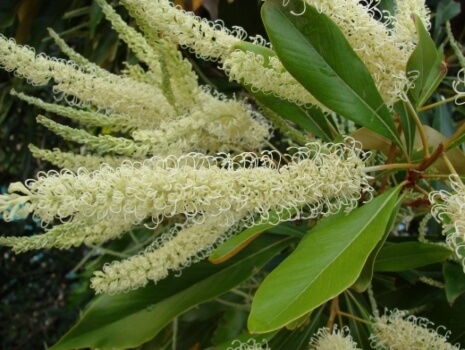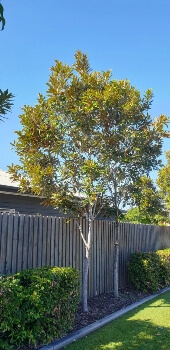The leaves of the Grevillea baileyana are lovely with a bit of a rusty colour underneath. In summer, the tree shows off with impressive cream flowers that smell like honey. The Brown silky oak is medium to large in size and in its natural rainforest habitat, they’ve been known to reach heights of 30 metres.
You’ll find Grevillea baileyana growing abundantly all the way from Melbourne to Queensland. The tree is low maintenance but you do need to watch out for the roots. They can be invasive so be aware of planting it close to any structures or piping that might be affected.
More...

Source: Wikipedia
Family: | Proteaceae |
|---|---|
Genus: | Grevillea |
Species: | G. baileyana |
Common Names: | Brown silky oak, White oak, Scrub beefwood |
Location: | Outdoor |
Type: | Trees |
Growth: | Up to 10 metres tall and 4 metres wide |
Sun requirements: | Sunny, Light shade |
Foliage Colour: | Green with a bronze/rust colour underneath |
Flower Colour: | White, cream |
Flowering: | Summer |
Fruit: | Small pod with a single seed |
Maintenance level: | Low |
Poisonous for pets: | No |
How to Grow Grevillea baileyana
Propagating Grevillea baileyana
It is possible to propagate Brown silky oak using fresh seed or cuttings featuring new growth. The best time to plant seed is during autumn or spring and try to maintain a temperature of between 18 and 22°C as this is best for seed germination.
Before planting, soak the seed in water for 24 hours and then sprinkle over a seed raising mixture and lightly cover it without burying the seed. The seed container should be placed somewhere warm and in the shade.
The growing mixture needs to stay moist between each watering session but make sure it’s still well-draining. Germination should happen between 21 and 60 days.
How to Care for Brown Silky Oak

Source: Citicene
- Sunlight - Grevillea baileyana can grow in sunny conditions but also does well in light shade.
- Soil - The Brown silky oak likes an acidic or neutral soil. It can grow happily in sandy or loamy soil that is preferably well-draining.
- Watering - You’ll need to give your Grevillea baileyana water regularly for at least the first 12 weeks while the tree is establishing itself. We recommend mulch as well.
- Pruning - You can prune your tree as needed to encourage growth and flower production and to maintain its shape.
- Fertiliser - Grevillea baileyana will do well with a native slow release fertiliser when you start to see the flower buds forming.
Pests and Diseases that Affect Grevillea baileyana
Grevilleas in general can struggle with fungal diseases such as root rot, sooty mould, and leaf spot. It’s also important to ensure that your fertiliser is not high in phosphorus as Grevilleas are sensitive to it.
It can end up burning the leaves of your Brown silky oak and can end up killing it.
Grevillea baileyana Frequently Asked Questions
Does the Grevillea baileyana have any special features?
The flowers that it produces look stunning cut and put in a vase. It’s a tree that grows quickly, and is loved by birds as a place to make their nests. The tree attracts bees, butterflies, and birds in search of delicious nectar.
Where does Grevillea baileyana get its name?
Grevillea is named after Charles Francis Greville who established the Royal Horticultural Society. Baileyana is named after Captain F. M. Bailey. He gave the tree its original name and classified it under the genus Kermadecia.


Get Your Free Guide:
Master Growing Australian Natives eBook
A Must Have Complete Guide for Every Australian Garden
Get Your Free Guide:
Master Growing Australian Natives eBook
A Must Have Complete Guide for Every Australian Garden
Want to know more about Grevilleas and other native Australian plants? Sign up for our newsletter.
For more Grevillea growing guides, check out our main Grevillea post.
Introduce the Graceful Beauty of Grevillea baileyana to Your Garden
Although Grevillea baileyana lives naturally in tropical rainforest, it will also live well in a cooler climate and even a dry soil. Grevillea baileyana can handle a light frost and will provide generous shade once it reaches full size.
Published on February 24, 2023 by Nathan Schwartz
Last Updated on January 25, 2025





